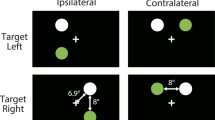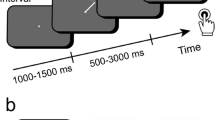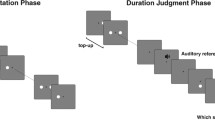Abstract
In this study, we used EEG to investigate how visual stimulus dynamics (i.e. flicker) affect the mechanisms of duration perception. Previous studies have demonstrated that flickering visual stimuli are judged longer than equally long non-flickering stimuli. We tested whether this effect of flicker on duration judgments is mediated by changes in temporal encoding during the time interval. Here, temporal encoding refers to the perception of the unfolding of time throughout the temporal interval, also termed the “clock stage” in information processing models of interval timing. We hypothesized that if flicker mediates duration perception by affecting temporal encoding, then the dilation-effect should be reflected by neural correlates of temporal encoding. We presented flickering and steady stimuli in a duration bisection task and found that flicker dilated perceived duration. The EEG analysis allowed us to isolate a putative neural correlate of temporal encoding: a modulation of the amplitude of the contingent negative variation (CNV) by stimuli classified as “long” compared to physically identical stimuli classified as “short”. However, flicker did not affect the CNV amplitude, suggesting that flicker does not dilate perceived duration by affecting temporal encoding. Possibly, flicker might affect only later stages of temporal processing such as interval comparison or decision making.



Similar content being viewed by others
References
Beckmann JS, Young ME (2009) Stimulus dynamics and temporal discrimination: implications for pacemakers. J Exp Psychol 35(4):525
Bendixen A, Grimm S, Schröger E (2005) Human auditory event-related potentials predict duration judgments. Neurosci Lett 383(3):284–288
Block RA (1990) Cognitive Models of Psychological Time. Erlbaum, Hillsdale
Brainard D (1997) The psychophysics toolbox. Spat Vis 10(4):433–436
Brown S (1995) Time, change, and motion: the effects of stimulus movement on temporal perception. Atten Percept Psychophys 57(1):105–116
Bueti D (2011) The sensory representation of time. Front Integr Neurosci 5:34
Buhusi C, Meck W (2005) What makes us tick? Functional and neural mechanisms of interval timing. Nat Rev Neurosci 6(10):755–765
Burle B, Casini L (2001) Dissociation between activation and attention effects in time estimation: implications for internal clock models. J Exp Psychol 27(1):195
Cai ZG, Wang R (2014) Numerical magnitude affects temporal memories but not time encoding. PLoS One 9(1):e83159
Church R (1984) Properties of the internal clock. Anna N Y Acad Sci 423(1):566–582
Delorme A, Makeig S (2004) EEGLAB: an open source toolbox for analysis of single-trial EEG dynamics including independent component analysis. J Neurosci Methods 134(1):9–21
Droit-Volet S, Wearden J (2002) Speeding up an internal clock in children? Effects of visual flicker on subjective duration. Q J Exp Psychol 55(3):193–211
Eagleman D, Pariyadath V (2009) Is subjective duration a signature of coding efficiency? Philos Trans R Soc B 364(1525):1841
Gibbon J (1977) Scalar expectancy theory and Weber’s law in animal timing. Psychol Rev 84(3):279
Grondin S (2008) Methods for studying psychological time. In: Psychology of time. Emerald Group Publishing Ltd, Bingley, pp. 51–74
Grondin S (2010) Timing and time perception: a review of recent behavioral and neuroscience findings and theoretical directions. Atten Percept Psychophys 72(3):561
Herbst SK, Javadi AH, van der Meer E, Busch NA (2013) How long depends on how fast—perceived flicker dilates subjective duration. PLoS One 8(10):e76074
Herbst SK, van der Meer E, Busch NA et al (2012) Attentional selection dilates perceived duration. Perception 41(8):883
Homan RW, Herman J, Purdy P (1987) Cerebral location of international 10–20 system electrode placement. Electroencephalogr Clin Neurophysiol 66(4):376–382
Ivry R, Schlerf J (2008) Dedicated and intrinsic models of time perception. Trends Cogn Sci 12(7):273–280
James W (1891) The principles of psychology, vol 1. Harvard University Press, Cambridge
Kanai R, Paffen C, Hogendoorn H, Verstraten F (2006) Time dilation in dynamic visual display. J Vis 6(12):1421–1430
Kelly S (2005) The puzzle of temporal experience. In: Brook A, Akins K (eds) Cognition and the brain: the philosophy and neuroscience movement. Cambridge University Press, Cambridge, pp 218–248
Kiebel SJ, Friston KJ (2004) Statistical parametric mapping for event-related potentials (ii): a hierarchical temporal model. Neuroimage 22(2):503–520
Kononowicz TW, van Rijn H (2011) Slow potentials in time estimation: the role of temporal accumulation and habituation. Front Integr Neurosci 5:48
Macar F, Vidal F (2004) Event-related potentials as indices of time processing: a review. J Psychophysiol 18(2):89–104
Macar F, Vidal F, Casini L (1999) The supplementary motor area in motor and sensory timing: evidence from slow brain potential changes. Exp Brain Res 125(3):271–280
Maris E, Oostenveld R (2007) Nonparametric statistical testing of EEG-and MEG-data. J Neurosci Methods 164(1):177–190
Meck WH (1983) Selective adjustment of the speed of internal clock and memory processes. J Exp Psychol 9(2):171
Ng KK, Tobin S, Penney TB (2011) Temporal accumulation and decision processes in the duration bisection task revealed by contingent negative variation. Front Integr Neurosci 5:77
Pelli D (1997) The videotoolbox software for visual psychophysics: transforming numbers into movies. Spat Vis 10(4):437–442
Penney TB, Gibbon J, Meck WH (2000) Differential effects of auditory and visual signals on clock speed and temporal memory. J Exp Psychol 26(6):1770
Penton-Voak IS, Edwards H, Percival A, Wearden JH (1996) Speeding up an internal clock in humans? Effects of click trains on subjective duration. J Exp Psychol 22(3):307
Pernet CR, Chauveau N, Gaspar C, Rousselet GA (2011) LIMO EEG: a toolbox for hierarchical LInear MOdeling of ElectroEncephaloGraphic data. Comput Intell Neurosci 2011:3
Prins N et al (2009) Psychophysics: a practical introduction. Academic Press, London
Rouder JN, Speckman PL, Sun D, Morey RD, Iverson G (2009) Bayesian t tests for accepting and rejecting the null hypothesis. Psychon Bull Rev 16(2):225–237
Treisman M (1963) Temporal discrimination and the indifference interval: implications for a model of the “internal clock”. Psychol Monogr 77(13):1–31
van Rijn H, Kononowicz TW, Meck WH, Ng KK, Penney TB (2011) Contingent negative variation and its relation to time estimation: a theoretical evaluation. Front Integr Neurosci 5:91
Wagenmakers E-J, Farrell S (2004) AIC model selection using akaike weights. Psychon Bull Rev 11(1):192–196
Walter W, Cooper R, Aldridge V, McCallum W, Winter A (1964) Contingent negative variation: an electric sign of sensori-motor association and expectancy in the human brain. Nature 203:380–384
Wearden J (2003) Applying the scalar timing model to human time psychology: progress and challenges. Hogrefe & Huber Publishers, Gottingen
Wearden JH (2004) Decision processes in models of timing. Acta Neurobiol Exp 64(3):303–318
Wearden JH, Edwards H, Fakhri M, Percival A (1998) Why “sounds are judged longer than lights”: application of a model of the internal clock in humans. Q J Exp Psychol 51(2):97–120
Wittmann M (2013) The inner sense of time: how the brain creates a representation of duration. Nat Rev Neurosci 14(3):217–223
Xuan B, Zhang D, He S, Chen X (2007) Larger stimuli are judged to last longer. J Vis 7(10):1–5
Acknowledgments
We thank Veronika Petrovych for help with the data acquisition. Sophie Herbst was funded by the Studienstiftung des deutschen Volkes.
Author information
Authors and Affiliations
Corresponding author
Rights and permissions
About this article
Cite this article
Herbst, S.K., Chaumon, M., Penney, T.B. et al. Flicker-Induced Time Dilation Does Not Modulate EEG Correlates of Temporal Encoding. Brain Topogr 28, 559–569 (2015). https://doi.org/10.1007/s10548-014-0389-z
Received:
Accepted:
Published:
Issue Date:
DOI: https://doi.org/10.1007/s10548-014-0389-z




